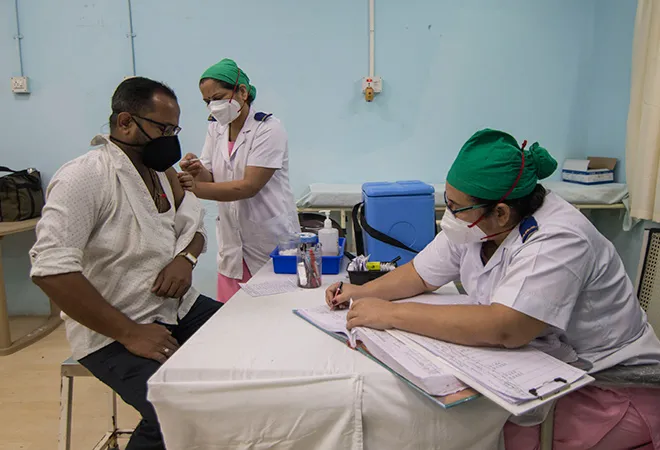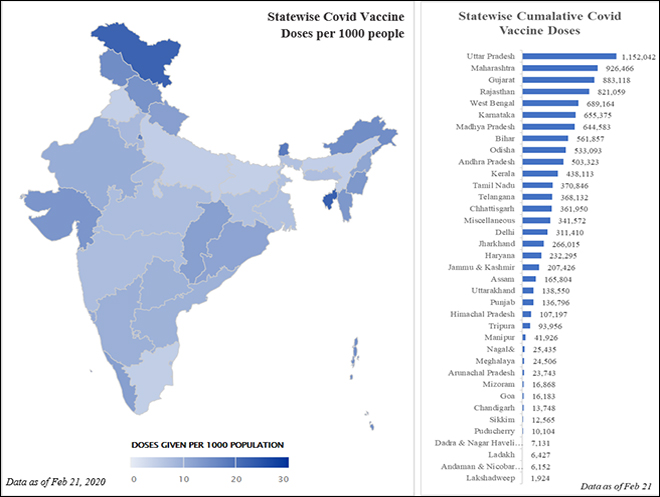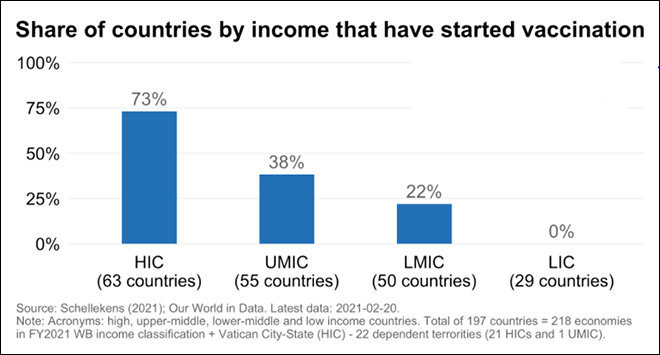
(This is part of the weekly series assessing the Covid-19 vaccine rollout in India and the world.)
The past week, roughly 30 million COVID-19 inoculations were conducted in the world. As of now, the Covid vaccine campaign has observed more than 208 million doses being administered globally, across 92 countries.
The average daily rate of doses administered is approximately 6.44 million doses per day. This rate has observed an increase of 38 percent in the past fortnight—from 4.68 million on Feb 8 to 6.44 million on Feb 21. Consequently, this increase has reduced the time needed for covering 75 percent of the global population with a two-dose vaccine to approximately 4.8 years, according to trackers. The steady rise in inoculations, coupled with consistent research into new vaccines and protective measures, looks promising.
Currently, there are 70 vaccines under clinical trials and another 181 vaccine candidates are in the pre-clinical investigation stages. Twenty one vaccine candidates have reached the final phases of testing in large-scale vaccine efficacy trials, while only four have been approved for full use, namely, Pfizer-BioNTech, Moderna (both Pfizer and Moderna were fully approved in Bahrain, Saudi Arabia, Switzerland, and but are in emergency use in U.S., E.U., and other countries), Sinopharm (approved in China, U.A.E., Bahrain) and Sinovac (conditional approval in China) vaccines.
On the other hand, vaccines such as Gamaleya Sputnik V (early use in Russia, emergency use in other countries), Oxford-AstraZeneca (emergency use in UK, EU and other countries), Bharat Biotech’s Covaxin (emergency use in India), CanSino (limited use in China) have received limited emergency approval. On February 16, post approval from authorities, India’s Bharat Biotech has also initiated the Phase 1 trials of the single-dose vaccine delivered as a Nasal Spray.
Figure 1: Global Covid Vaccine Trend
 Author’s own, data source: Our World in Data
Author’s own, data source: Our World in Data
Presently, the Covid vaccine drive is led by the United States, with more than 63 million doses administered, as of February 21, followed by China (40 million<1>), UK (18 million) and India (11.1 million). While USA and China lead in absolute doses administered, Israel’s inoculation surpasses that of other countries with 78.8 doses administered for every 100 people. USA and China seem to be lagging behind with 19 and 2.8 doses per 100 population, largely attributed to a high population base.
Figure 2: Country wise Covid vaccine doses administered
 Author’s own, Data source: Bloomberg Vaccine tracker
Author’s own, Data source: Bloomberg Vaccine tracker
India’s Covid Vaccine Update
India’s total confirmed cases have surpassed 11 million, with an increase of 79,804 cases in the past week. Recoveries in India saw an increase to 10.6 million, while 83 Covid deaths were reported in the past 24 hours, taking the total to 156,423, as of Feb 21.
India has administered more than 11.1 million doses, making India the fourth highest country in terms of total vaccine doses administered, with 0.8 doses administered per 100 people. In the past week, India conducted approximately 2.4 million inoculations. India’s average daily vaccination rate saw a rise of 15 percent this past week, from 353,276 (as on the week ending on Feb-14) to 404,508 (as on the week ending Feb-21). The figure below shows India’s daily vaccinations, with a steep fall seen on the weekends due to closure of most government facilities. The daily numbers have not shown the acceleration that India requires to cover the 300 million high priority population quickly, and this can prove costly if there is another wave.
Figure 3: Covid Vaccine Trends in India
 Author’s own, Data source: Ministry of Health and Family Welfare, Government of India
Author’s own, Data source: Ministry of Health and Family Welfare, Government of India
Uttar Pradesh continues to lead the country with more than 1.1 million doses administered, while Union Territories Lakshadweep lags behind with 1,924 doses. When closely observing the vaccine stats, Lakshadweep leads with 26 doses administered per 1000 people, but Punjab and Bihar lag behind with 4.5 doses per 1000 people, each.
Figure 4: Covid Vaccine Trends in Indian States
 Author’s Own, Data source: Observer Research Foundation Vaccine Tracker
Author’s Own, Data source: Observer Research Foundation Vaccine Tracker
An equitable way forward
This week observed multiple new countries initiating their vaccine drives. The number of countries conducting Covid vaccine drives increased from 73 to 92 over the past two weeks. However, the access to vaccines remains partial to high and upper middle-income countries. For instance, Canada’s Covid vaccine contracts will potentially cover 126 million people—which is 335 percent of their population, while African countries continue to lag behind with ~5-6 percent of their population covered by the current vaccine contracts.
Estimates suggest that 16 percent of the world’s population has acquired 60 percent of the Covid vaccine doses. Even though vaccine makers across the world had promised ‘equitable access’ of the vaccines; as of now, most contracts have been awarded to rich countries.
Figure 5 shows the lack of equity in vaccine distribution globally, wherein no low-income country has begun its vaccination drive. After more than two months of the ongoing vaccination campaign, most high-income countries have been able to secure vaccine contracts and initiate the vaccination drives for their population. In contrast, only 11 lower middle-income and no low-income countries have started the vaccination drive.
Figure 5: Covid Vaccine’s Inequitable coverage
 Source: PandemIC Vaccine Equity Tracker, Feb 21, 2021
Source: PandemIC Vaccine Equity Tracker, Feb 21, 2021
India: The pharmacy of the world #VaccineMaitri
Amidst the pandemic, India has stepped up to support its fellow nations through its efforts to provide cost effective vaccine doses around the world. India is set to become the second largest Covid vaccine maker, with the aim of producing 3.5 billion doses in 2021. India has already rolled out approximately 24 million doses under its ‘Vaccine Maitri’ (means ‘Vaccine Friendship’) programme, out of which 6.5 million were supplied as grants. The country aims to supply low cost or free Covid vaccine doses to 49 Latin American, Caribbean, Asian and African countries. Last week, India also promised 200,000 doses to UN peacekeepers around world.
In addition to supplying vaccines to India and its other clients, the Serum Institute of India (SII) will be providing both the Oxford-AstraZeneca vaccine and the Novavax vaccine to 92 low-and-middle income countries under Covax—a global vaccination initiative. The SII, that produces 50 million doses monthly, will be expanding to 100 million by March end. Earlier this month, preliminary analysis suggested that the Oxford-AstraZeneca vaccine will be effective against the newer Covid strains found in UK, Brazil and South Africa. On the other hand, another study suggested that CoviShield vaccine could reduce transmission by 67 percent, with the efficacy rising if the two doses are taken at longer intervals.
India’s vaccine diplomacy efforts have gained widespread praise around the world. While the country has provided millions of doses to support others, it now aims to ramp up its own vaccination drive. Serum Institute’s CEO Adar Poonawalla has requested nations to remain patient while the company attempts to strike the balance between the needs of India and the rest of the world. It remains unclear whether this statement was a result of instructions from the Government of India, or just a ploy to buy more time in a situation where global demand for Covishield has outrun its supply.
While India has been rigorously attempting to vaccinate its priority population, efforts have produced slower than expected results. It has been reported that country intends to increase the daily rate of its vaccines to 5 million doses a day in the coming weeks. Reportedly, the involvement of private firms and institutions can aid the vaccination of over 500 million people in less than six months. Although the public health system in India has been performing well the past few weeks, India requires the aid of its private medical sector to reach its vast and segregated population.
<1> China’s vaccination data not updated after Feb 9
The views expressed above belong to the author(s). ORF research and analyses now available on Telegram! Click here to access our curated content — blogs, longforms and interviews.




 Author’s own, data source:
Author’s own, data source:  Author’s own, Data source:
Author’s own, Data source:  Author’s own, Data source:
Author’s own, Data source:  Author’s Own, Data source:
Author’s Own, Data source:  Source:
Source:  PREV
PREV


